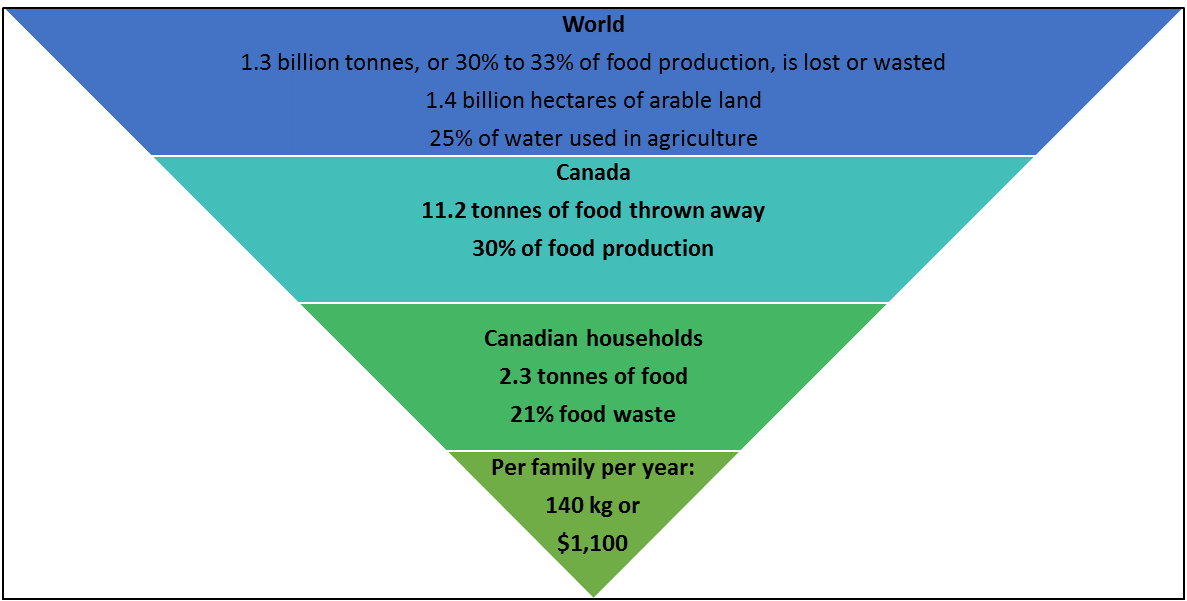| Environmental Columns
Fighting food waste
The Food and Agriculture Organization of the United Nations (or FAO) estimated in 2011 that, globally, one-third of total food production is lost or wasted each year. In a 2019 study, researchers estimate that 30% of the food available in Canada is lost or wasted in a way that could have been avoided. This represents 11.2 tonnes of food, enough to feed all Canadians for five months.
Figure 1. Food waste figures
What is food waste?
According to Recyc-Québec, food waste is generally defined as any food intended for human consumption that is lost or thrown away along the bio-food chain.
Food waste has repercussions that go beyond the loss of food. Producing, transporting, processing and packaging this discarded food requires land for agriculture (plant crops and livestock), water to irrigate the land, water for animals, food preparation and processing, plant protection products and hours of work. Thus, by wasting the food produced, ecosystems are also unnecessarily exploited and various resources are lost. Added to this are greenhouse gas emissions associated with transporting goods, sometimes over thousands of kilometres, as well as with producing and transporting the pesticides and fertilizers used.
Generally, in Canadian households, fruits and vegetables are wasted the most (45% of food waste), followed by leftovers and other foods, such as snacks, staples, beverages, desserts and oils or fats (33%). Meat and other animal products account for 13% of waste. The National Zero Waste Council’s “Love Food Hate Waste” initiative conducted a study in 2017 reporting that 63% of consumer food waste was preventable. The remaining 37% is bones, shells and coffee or tea grounds.
Why do we waste food?
These figures show that the consumer food waste phenomenon is an economic, social and environmental problem on a global scale. There are several reasons for it:
- In stores, less well stocked shelves can give the impression of a lack of supply or poor management, leading to dissatisfaction and reduced purchases. To avoid this misperception, retailers are pushed to constantly fill the shelves.
- The “best before” equals “bad after” effect: consumers often refuse to eat or drink food that is past its expiry date. Yet some low-perishable products can still be consumed. While they may lose their freshness and nutritional quality, they are still safe to eat.
- Refusal to eat products that don’t follow the conventional esthetic: a two-legged carrot, a misshapen tomato, a banana that is turning black. These are all examples of edible fruits that are not acceptable to consumers. These requirements lead retailers to remove unsightly products from counters and shelves, and consumers to throw away fruits and vegetables that are damaged but still good at home.
- The positive social image of abundance: Food abundance has always been a sign of well-being and wealth. We therefore prefer to buy so that we always have a full pantry or refrigerator and can offer hearty, and sometimes lavish, meals to our family or guests.
- The desire to eat a variety of foods for health or pleasure can also lead people to avoid storing leftovers.
- There may be a lack of time for grocery shopping and meal preparation. Lack of planning and time can lead to buying products that are not needed, that we already have or that are not eaten quickly enough.
Whether for fear of damaging their health or to follow moral and conventional food values, people waste more than they think. Fortunately, it is possible to develop good habits to reduce food waste.
How to take action to reduce food waste
The first step is to become aware of the habits that lead us to throw away food without always being aware of it. Once this awareness is established and accepted, practices can be implemented to reduce food waste at home and indirectly, in grocery stores.
- Plan your meals for the week and shop accordingly. By taking the time to plan, you can go through the fridge and pantry, making it easier to know what foods to buy for the week. What’s more, once the week’s meals have been planned, you no longer have to waste time wondering what to eat, or doing last-minute groceries. An additional tip: avoid doing groceries on an empty stomach! Feeling hungry leads to buying products we don’t need.
- Buy what you need and buy more often. It may seem practical and cost-effective to buy in large amounts; however, sometimes the amounts are not appropriate for your needs. Food that is not eaten right away is then lost if it is perishable or takes up too much space in the cupboard. Bulk purchases can be a good way to buy the amounts you need.
- Organize your refrigerator to keep food fresh longer. To help you with this, the National Zero Waste Council has created a Fridge Guide.
- Place foods that need to be finished in front of the fridge and foods that can be stored longer in the back.
- Use clear containers so you can readily see what’s in them and won’t forget about them.
- Eat leftovers by reheating them as is or using them with other foods to create a complete and different meal.
- Trust your senses when checking food safety. Changing odours, appearances and textures are good indicators of the food’s condition.
- Freeze large quantities. Many foods freeze well for several weeks or months. The Ministère de l’Agriculture, des Pêcheries et de l’Alimentation du Québec has produced the “Thermoguide” (in French only), which indicates the length of time foods can be stored in the refrigerator and freezer, by food category.
- Be creative with your cooking. You can make stir-fries, casseroles, soups, quiches and salads with what you have on hand. Experiment and improve your recipes as you go!
- Adjust recipes according to the ingredients you have on hand. If a recipe calls for an ingredient you don’t have, think of an alternative so that you can replace it with something you do have.
- Donate food. If you are thinking of getting rid of foods that are not perishable or low-perishable, you can look for food banks that will accept them or share them with others.
Finally, as a last resort, dispose of food residues in your compost bin. Although this measure does not prevent food waste, it diverts organic matter from landfills to be turned into compost.
There are many ways to work toward zero waste! By reducing food waste, you can lower the volume of your compost bin and, most importantly, help fight a complex problem. To put these tips into practice, consult the following resources:
- Cuisiner mieux en jetant moins, Casali Lisa, Larousse, 2013.
- L’art de cuisiner sans gaspiller ni se ruiner, Siry, Florence-Léa, Caractère, 2015.
- Les conserves selon Camilla. Le nouvel art de mettre en pot, Wynne, Camilla, Caractère, 2013.
- Mieux conserver ses aliments pour moins gaspiller, Desbiens, Anne-Marie, La Presse, 2019.
- Sauve ta bouffe: Guide et recettes pour réduire le gaspillage alimentaire au quotidien, Les amis de la Terre de Québec, Éditions Goélette, 2020
- Sauver le monde une bouchée à la fois, Lavallée, Bernard, La Presse, 2015.
- Tout manger de A à Z, Dupuis-Gaulier, Sophie, Hachette Cuisine, 2014.
- Bread Is gold: Extraordinary Meals with Ordinary Ingredients, Bottura, Massimo, Phaidon Press limited, 2017
- Hard, Lindsay-Jean, Workman Publishing, 2018
- How to Cook Everything, Bittman, Mark, Houghton Mifflin, 2013.
- Scraps, Wilt & Weeds: Turning Wasted Food into Plenty, Refslund, Mads and Matsouka Wong, Tama, Grand Central life and style, 2017
- Secrets of Great Second Meals: Flexible Modern Recipes That Value Time and Limit Waste, Dickerman, Sara, Harper Collins, 2019
- MAPAQ (s.d.) Meilleur avant, bon après ? (in French only)Found at https://www.mapaq.gouv.qc.ca/fr/Publications/Meilleuravant_Bonapres.pdf
- MAPAQ (2017). (in French only) Thermoguide : frais c’est meilleur. Found at https://www.mapaq.gouv.qc.ca/fr/publications/thermoguide.pdf
References
RECYC-QUÉBEC. (2019). Gaspillage alimentaire. Found at https://www.recyc-quebec.gouv.qc.ca/citoyens/mieux-consommer/gaspillage-alimentaire
Docteur bonne bouffe. (2017, 29 mars). 17 fruits et légumes à consommer au mois d’avril. Found at https://docteurbonnebouffe.com/calendrier-fruits-legumes-avril/
Planet addict. (2014, April 11). 10 astuces pour limiter le gaspillage alimentaire. Found at https://planetaddict.com/limiter-le-gaspillage-alimentaire/
National Zero Waste Council (2018). Love Food Hate Waste Canada: https://lovefoodhatewaste.ca
Tu vas pas jeter ça ? (2019). Les plus récents chiffres sur le gaspillage alimentaire au Canada. Found at https://tuvaspasjeterca.com/2019/05/30/les-plus-recents-chiffres-sur-le-gaspillage-alimentaire-au-canada/
Sauve ta bouffe. (2020). Le gaspillage et ses enjeux. Found at https://sauvetabouffe.org/gaspillage-alimentaire/

